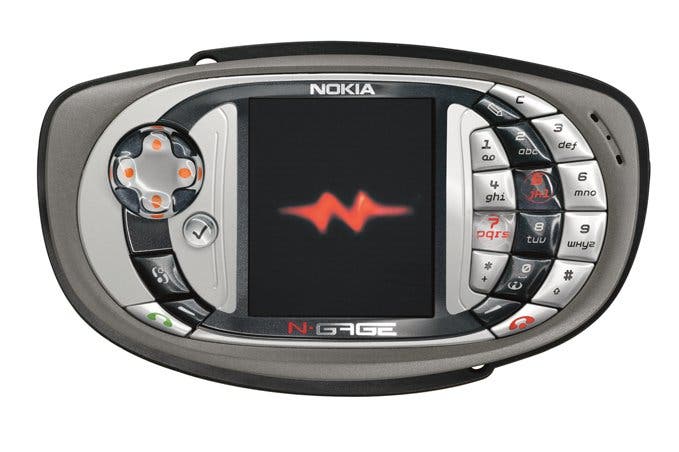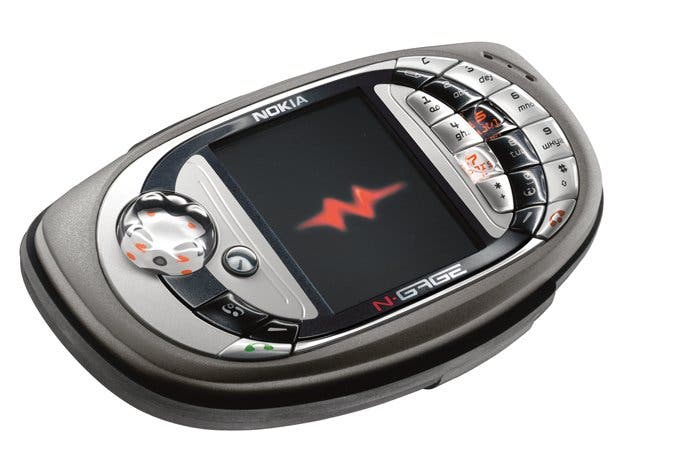Nokia N-Gage QD
The second generation of the N-Gage hardware is here - and we've spent a couple of days putting it through its paces in order to bring you a full hands-on report on Nokia's second effort at getting it right in the games market.
John Riccitiello, Electronic Arts' former president and COO who departed from the company only last week, may well have put it most succinctly. "When I picked it up I knew it was a dog," he said of the original N-Gage game deck, "it just feels stupid." However, he wasn't entirely damning in his condemnation of the platform. "Nokia will figure it out," he predicted. "It's just that they haven't figured it out yet."
With the unveiling of the N-Gage QD, Nokia has its second stab at figuring it out - a chance to implement changes based on a year's worth of valuable, if undoubtedly unpleasant, feedback from media, consumers, publishers and developers on a device which is widely considered to feature some of the worst design decisions the games industry has ever seen.
We've already spent substantial time with the N-Gage QD, using one of the prototype devices as a phone and game console over the course of a hectic couple of days in Nokia's home town of Helsinki. Although the device we tested was running a beta version of the operating system, the vast bulk of the functionality was in place and we were able to give the new N-Gage a proper run through the majority of its paces.
Early Impressions

You only get one chance to make a first impression, and the N-Gage QD makes the most of that chance. Unlike its older stablemate, which is designed very similarly to a number of Nokia's other phones and is even built from the same materials, the QD is quite a unique beast - completely unlike any other phone we've ever used, with a chunky, substantial feel to it which is much more becoming of a serious games device than the design of the original N-Gage. The material of the casing feels tougher, the buttons are made of thick, slightly rubberised plastic and stick out prominently from the fascia, and there's even a soft rubber ring around the edges of the QD which should help to protect it from falls. The addition of tight rubber flaps around all external ports and a well-sealed battery compartment probably mean that the phone is also splash proof to some degree, although Nokia doesn't seem keen to push that as a feature.
The QD is sufficiently rugged that it feels almost like a piece of military hardware rather than a games console, and we expect that this look will appeal to a lot of consumers - particularly young men in the console's prime age bracket of late teens through to mid-twenties. Crucially, it's a design which is very unique without being unattractive or impractical - and the ability to replace the front fascia and keys with new ones will also appeal to the fashion conscious, as well as offering the possibility of game companies releasing new fascias as merchandising for their latest titles on the system.
As you would hope, the two key problems with the original N-Gage system have been fixed in its successor - namely the need to remove the battery in order to change MMC game cards, and the ludicrous "sidetalking" positioning of the microphone and speaker, which made users of the phone look like they were talking into a taco (or a pasty, depending on which part of the world you hail from). The former issue has been fixed comprehensively by putting an MMC card slot on the outside of the console, covered by a rubber flap, while the latter has simply been fixed by moving the earpiece and microphone onto the front fascia of the phone.
In allowing users to hot-swap MMC cards, Nokia has also added software functionality which lets you launch games from the main screen without having to navigate through menus, or even have the game start up as soon as the card is inserted, much like more traditional games consoles. In order to remove the card, however, you must first click on a menu option for safe removal, and we noted that the MMC slot on our prototype unit wasn't spring loaded, so careful prising of the card end with a thumbnail was required to retrieve it. However, compared to the previous mechanism for game changing, this is near perfect.
Front Talkin'

The relocation of the earpiece and microphone onto the front panel is also a success, and the QD can happily be used as a phone without the need for a hands-free kit. In fact, it's very comfortable to use as a phone, as it fits snugly into your hand and the built-in speaker is very clear and quite loud. Our only gripe was that the button for answering calls doesn't seem large and prominent enough, which is actually a problem with a number of the function buttons on the fascia. However this is probably due to the constraints imposed by the need to make the phone overall smaller than the original N-Gage, and users of the QD will probably get used to the new, smaller positions of certain keys quite quickly.
The other major enhancement to the N-Gage QD is that the screen is now significantly brighter and clearer than on the original model of the device, which makes a number of games - particularly the darker 3D ones - a lot easier and more fun to play. However, the actual size and shape of the screen hasn't changed, and we still have reservations about both the size and the update rate of the screen - not least because even with the new, sharper screens, some people were complaining of headaches after playing with their N-Gage QD's for relatively short periods of time.
All in all, then, as cosmetic overhauls go the N-Gage QD has largely been a success for Nokia; they have taken what was frankly an unattractive and inconvenient device and turned it into a genuinely good piece of hardware which should have a broad appeal within the youth market.
However, the reduction in size - and in price tag - has come at a cost, and the QD lacks much of the additional non-gaming functionality of the original N-Gage and the rest of Nokia's Series 60 phones. In a move which may well have been designed to avoid cannibalising customers from other parts of Nokia's lucrative mobile phone business, a swathe of features have been removed from the N-Gage - although with a small number of exceptions, they can be added back into the device by downloading third party Symbian applications.
Among the functions which are missing from the phone are the MP3 player (easy to download, admittedly), the FM radio tuner (which cannot be replaced in software as it requires custom hardware) and a number of PDA-style applications which are common on Series 60 phone handsets. Presumably the removal of those functions - particularly the MP3s playback - rendered the USB port on the phone pointless, as it is also missing from the design of the QD.
In the Balance

For customers who are actually interested in the PDA and music playback functions of the device, the N-Gage QD isn't going to look as attractive as to others - which is presumably why Nokia is planning to leave the N-Gage in its range rather than replacing it entirely. However, we tend to agree with the bulk of the design decisions made here, not least since standalone MP3 players and PDAs have become so completely ubiquitous and offer far more functionality and quality than a multi-purpose device such as the N-Gage could ever hope to. Nokia claims that its customer feedback suggested that people were happy to sacrifice the extra functions in order to gain a smaller device and a smaller price tag; the truth of this one will presumably be seen in public reaction to the new device.
In terms of playing games on the deck, not a lot has changed since the original N-Gage - unsurprising, since the actual innards of the device are exactly the same as its older sibling. All games will continue to be compatible with both consoles, meaning that owners of the original N-Gage who wish to continue using it won't be hung out to dry over new releases. One thing which has improved slightly, however, is the control layout. Keys are now far more significantly raised and easier to locate with the fingers, as well as having a far more positive action when pressed, and the company has wisely removed the "click" action from the D-pad, moving it onto a small button next to the pad instead in order to avoid players hitting the click at an inopportune moment during a game.
Nokia claims to have boosted the battery life of the system significantly also, and cites up to ten hours of playtime for the device. We were unable to test that claim, but certainly the phone appeared to be losing its charge a lot more slowly than an original N-Gage - and if the ten-hour claim is true, the device will be on a par with Nintendo's Game Boy Advance SP for usability in this specific department.
That's more like it...
There's absolutely no doubt that the N-Gage QD is a vast improvement over the original N-Gage, as it fixes a number of major showstopper problems with the first generation hardware and introduces an attractive, functional and comfortable-to-use design which makes the QD into arguably one of Nokia's most desirable Series 60 phones from a pure aesthetics point of view. Obviously, the design won't appeal to everyone, and we expect it to polarise opinion to some degree - but barring any major hitches, when we finally get our hands on a QD for a proper extended testing period, we feel safe in saying that Nokia finally has a games console which could be a winner with the general public. Now it's just down to the Finnish company to provide the compelling software reasons that people will need to buy one...


.png?width=291&height=164&fit=crop&quality=80&format=jpg&auto=webp)




.jpg?width=291&height=164&fit=crop&quality=80&format=jpg&auto=webp)
